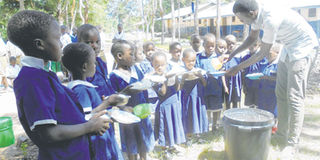Good nutrition matters for the early years

School children in Mwanza line up for lunch time.PHOTO|JOVITHER KAIJAGE
What you need to know:
- However, the demand for information on proper child nutrition in early stages of life still leaves a lot to be desired.
- According to United Nations Children’s Fund (UNICEF), the current rate of stunting among children in the country is only two percentage points lower than it was five years ago, thanks to interventions by the government and stakeholders.
Current data that 42 per cent of children in Tanzania under the age of five are stunted is seen by experts as an improvement compared to the bad situation that existed five years ago. However, the demand for information on proper child nutrition in early stages of life still leaves a lot to be desired.
According to United Nations Children’s Fund (UNICEF), the current rate of stunting among children in the country is only two percentage points lower than it was five years ago, thanks to interventions by the government and stakeholders.
Support groups aids in awareness
For Pamela Seleman, 35, who has decided to join a WhatsApp group of 50 women to learn the best practices of breast-feeding, learning how to nourish a child in the early stages of life, is still a tough challenge that authorities must address nationally.
Pamela says when she had her first child; she did not know how best to feed him, “I have now learnt that if a child is not breast-fed appropriately, he/she is likely to suffer from complications of malnutrition.”
Pamela spoke to Your Health last week when she teamed up with other women at the Aga Khan Hospital (AKH) in Dar es Salaam during an event to mark the end of the World Breast Feeding Week.
According to the World Health Organisation’s Director General, Dr Tedros Adhanom, governments, development partners and the media must now work towards promoting breast-feeding.
He said, at the beginning of the week that it was time to work together to strengthen existing partnerships and forge new ways to invest in and support breastfeeding for a more sustainable future.
As the breast-feeding week ended, the AKH formed an initiative, the “Breastfeeding Support Group” that includes 50 women in each group—expectant women and new mothers—with an educator in the group who raises awareness on the best practices of breastfeeding.
Pamela, one of the beneficiaries says, “There are women with more experience on breast feeding and experts who can help us learn the best practices. That’s why I’m joining other women in a WhatsApp group to learn,” she says.
A paediatrician at AKH, Dr Mariam Noorani, says the initiative to help women improve breast-feeding practices is in line with current efforts by the government to cut down the rate of malnutrition and improve early childhood development.
The first 1000 days of child’s life
Other experts believe that efforts should be invested in educating parents and guardians on the importance of investing in the first 1000 days of a child’s development—especially on the role played by proper nutrition. One of the key aspects is proper breast-feeding.
Dr Laurian Katengesha, a medical doctor in Dar es Salaam, says, “A child’s brain develops faster in the first two years than any other time.”
He adds, “Children who lack good nutrition and care at this period will end up with poor cognitive, this will results in poor learning ability and lack of concentration during class.”
He further explains that the first 1000 days are also important for physical growth and immunity development.
That a child who is deprived of good nutrition and care at this period, is at risk of being affected academically in future.
According to Professor Linda Richter, the co-author of Lancet series in investing in early childhood development, the first 1‚000 days of a child’s life are clear predictors of their future earnings.
This, Richter says, goes on to affect their health status and determines whether they get diabetes or heart disease and how many years of school they will complete.
Researchers says children with insufficient growth by the age 1000 days will have poor school achievement, early school dropout, low skills in employment and they will earn 26 per cent less per year as adult, regardless of what happens after the age of two.
Challenges women face on early feeding of their child
A clinical epidemiologist and a research scientist from the Ifakara Health Institute (IHI) Dr Frederick Haraka says that the challenges faced by women when it comes to breastfeeding are related to the socio-economic changes.
He says, “Historically, developing countries particularly Africa did not have much of problems with breastfeeding. This was mainly due to cultural and support systems which were strong in the communities as well as mothers weren’t expected much on working to earn for the family rather support and look after the children.”
“This was in the past, and had a huge downside of marginalising mothers in contributing to economic development as well as individual career development and talent growth,’’ adds Dr Haraka.
He says the situation has begun to change, “Thanks to the efforts on empowering women that trends are increasingly changing. More women are becoming employed in different positions, active in economic activities.”
When socio-economic status matters
For Dr Baraka Maginga of Pasiansi Health Centre in Mwanza Region, better nutritional status of children is a cumulative effect of a series of more favourable socioeconomic conditions that result from better caring practices for children from their mothers.
Dr Maginga says malnutrition is a condition which occurs when there is a deficiency of certain vital nutrients in a person’s diet.
He says the deficiency fails to meet the demands of the body, leading to effects on the growth, physical health, mood, behaviour and other functions of the body.
Government efforts
Tanzania has made significant progress in many health indicators over the past decade, but little gained on nutritional status, data from the Ministry of Health, Community Development, Gender, Children and Elderly show.
Mwanza Region’s Food and Nutrition Officer, Ms Sophia Lazarus says the targets of controlling malnutrition in children under the age of five are hampered by socioeconomic constraints and lack of enough education among the rural people.
“The region has a serious problem on stunting cases particularly on children under the ages of five. This has been caused by various aspects including poor diets amongst family,” she says.
She says that the region is now banking on the efforts by Non-Governmental Organisation in trying to fight against stunting.
She advised mothers and caretakers to feed their children for at least five meals a day, adding that children’s eating habits are different from mature people.
Details from her office in the region show that in 2016, Sengerema district led with 646 children aged below five with malnutrition.
In Kwimba district, there were 437 children; Buchosa council had 262 and Misungwi district had 188. In Mwanza city, Ilemela district recorded 35 cases.
She attributes the problem to the parents and guardian’s lack of full commitments to their children and lack of proper information on how to feed the children back at home.
A study conducted by the International Food Policy Research Institute in 2014 shows that choices and opportunities of people in urban areas differ from those of rural dwellers.
The study used data from the Demographic and Health Survey (DHS) from 36 developing countries to address the question of whether the socioeconomic determinants of child nutritional status differ across urban and rural areas.
The aspects surveyed, ranged from employment conditions to social and family networks and how they access healthcare and other services.
The Mwanza regional medical officer, Dr Leonard Subi, says anaemia, vitamin deficiency and stunted growth are the notable problems in the region.
“Most of the groups affected by these problems are the children aged less than five years, adolescents, pregnant women and breastfeeding mothers,” says Dr Subi.
Data from the regional medical office show among women aged 14 to 49, over 45 per cent are anaemic and it’s due to inadequate intake of foods rich in iron and folic acid.
Additional reporting by John Namkwahe.




